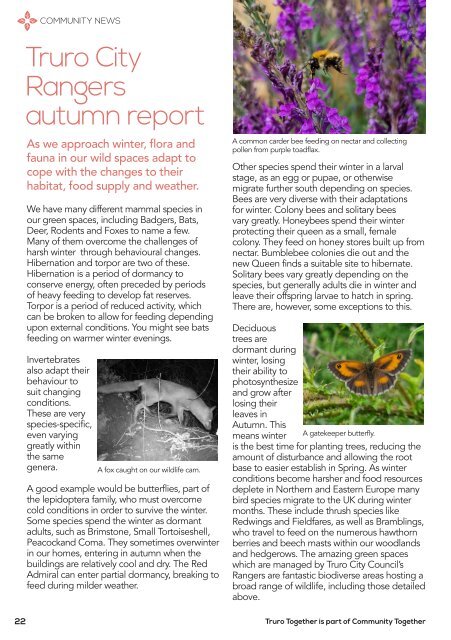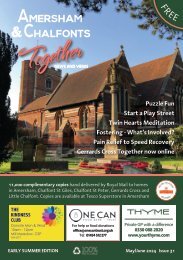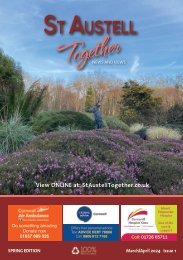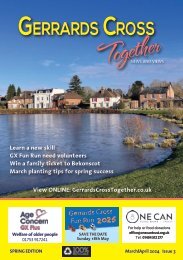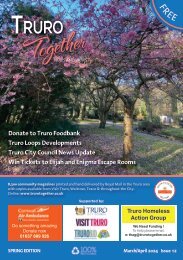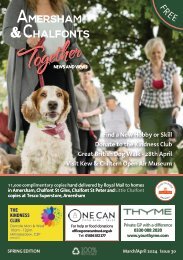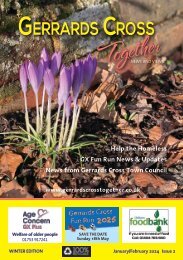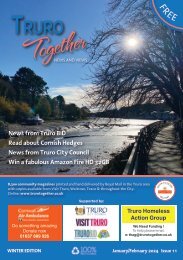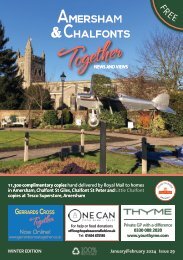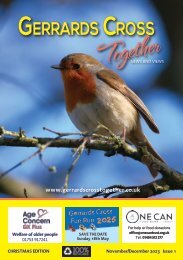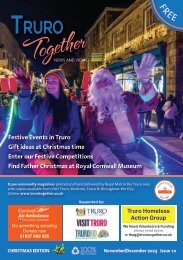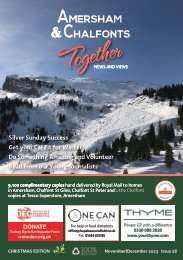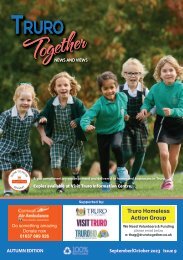Truro Together November December 2022
A local #community magazine containing community, business and charitable editorial in the the Truro, Cornwall area. 8,300 copies printed and hand delivered by Royal Mail to residences and businesses in TR1 1 and TR1 2 postal code areas. Copies available at Visit Truro Information Centre and Tescos in Truro.
A local #community magazine containing community, business and charitable editorial in the the Truro, Cornwall area. 8,300 copies printed and hand delivered by Royal Mail to residences and businesses in TR1 1 and TR1 2 postal code areas. Copies available at Visit Truro Information Centre and Tescos in Truro.
Create successful ePaper yourself
Turn your PDF publications into a flip-book with our unique Google optimized e-Paper software.
COMMUNITY NEWS<br />
<strong>Truro</strong> City<br />
Rangers<br />
autumn report<br />
As we approach winter, flora and<br />
fauna in our wild spaces adapt to<br />
cope with the changes to their<br />
habitat, food supply and weather.<br />
We have many different mammal species in<br />
our green spaces, including Badgers, Bats,<br />
Deer, Rodents and Foxes to name a few.<br />
Many of them overcome the challenges of<br />
harsh winter through behavioural changes.<br />
Hibernation and torpor are two of these.<br />
Hibernation is a period of dormancy to<br />
conserve energy, often preceded by periods<br />
of heavy feeding to develop fat reserves.<br />
Torpor is a period of reduced activity, which<br />
can be broken to allow for feeding depending<br />
upon external conditions. You might see bats<br />
feeding on warmer winter evenings.<br />
Invertebrates<br />
also adapt their<br />
behaviour to<br />
suit changing<br />
conditions.<br />
These are very<br />
species-specific,<br />
even varying<br />
greatly within<br />
the same<br />
genera.<br />
A fox caught on our wildlife cam.<br />
A good example would be butterflies, part of<br />
the lepidoptera family, who must overcome<br />
cold conditions in order to survive the winter.<br />
Some species spend the winter as dormant<br />
adults, such as Brimstone, Small Tortoiseshell,<br />
Peacockand Coma. They sometimes overwinter<br />
in our homes, entering in autumn when the<br />
buildings are relatively cool and dry. The Red<br />
Admiral can enter partial dormancy, breaking to<br />
feed during milder weather.<br />
A common carder bee feeding on nectar and collecting<br />
pollen from purple toadflax.<br />
Other species spend their winter in a larval<br />
stage, as an egg or pupae, or otherwise<br />
migrate further south depending on species.<br />
Bees are very diverse with their adaptations<br />
for winter. Colony bees and solitary bees<br />
vary greatly. Honeybees spend their winter<br />
protecting their queen as a small, female<br />
colony. They feed on honey stores built up from<br />
nectar. Bumblebee colonies die out and the<br />
new Queen finds a suitable site to hibernate.<br />
Solitary bees vary greatly depending on the<br />
species, but generally adults die in winter and<br />
leave their offspring larvae to hatch in spring.<br />
There are, however, some exceptions to this.<br />
Deciduous<br />
trees are<br />
dormant during<br />
winter, losing<br />
their ability to<br />
photosynthesize<br />
and grow after<br />
losing their<br />
leaves in<br />
Autumn. This<br />
means winter<br />
A gatekeeper butterfly.<br />
is the best time for planting trees, reducing the<br />
amount of disturbance and allowing the root<br />
base to easier establish in Spring. As winter<br />
conditions become harsher and food resources<br />
deplete in Northern and Eastern Europe many<br />
bird species migrate to the UK during winter<br />
months. These include thrush species like<br />
Redwings and Fieldfares, as well as Bramblings,<br />
who travel to feed on the numerous hawthorn<br />
berries and beech masts within our woodlands<br />
and hedgerows. The amazing green spaces<br />
which are managed by <strong>Truro</strong> City Council’s<br />
Rangers are fantastic biodiverse areas hosting a<br />
broad range of wildlife, including those detailed<br />
above.<br />
22 <strong>Truro</strong> <strong>Together</strong> is part of Community <strong>Together</strong>


